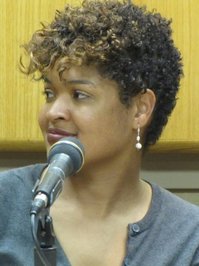
Speaker discusses trigger warnings
By Albert Ivory, Staff Writer
Photo courtesy of Goodreads.com
Towson University hosted its annual John Gissendanner Memorial Lecture April 30th. The theme for this year’s lecture was “Trigger Warnings: African American Novels and Racial Trauma.”
The lecture is a tribute to the late John Gissendanner, who was a director of the African and African American Studies program and a professor in the Department of English.
“John had a tremendous impact on this campus,” said Donn Worgs, the director of the African and African American Studies program. “We also remember his humor, enthusiasm, especially regarding issues on African and African American Studies.”
Towson University created the John Gissendanner Fund for African American study to support the work of the African and African American Studies program and honor his contribution to the institution.
The guest speaker was Dolen Perkins-Valdez, author of The New York Times bestselling novel “Wench.”
Perkins-Valdez recalled a conversation that she was having with a woman about books having warning labels.
“She was talking about labels that was going to warn readers that it’s going to be difficult to read,” she said.
She asked the woman what would the label look like. The woman provided examples, such as “This following text contains graphic sexual violence or images that may be disturbing to some readers,” and “[This book] contains behavior and descriptive language akin to potential self harm and references.”
Perkins-Valdez felt an initial resistance to these labels. She noted that there’s a difference between having a psychological inversion, which is distaste or revulsion, and being triggered, which is being physically and psychologically incapacitated. This sparked her curiosity and she wondered if she had ever had these experiences.
Perkins-Valdez then discussed her 2013 trip to the Museum of the Confederacy, now called the American Civil War Museum. A man that helped her with directions to the museum asked her if she was sure she wanted to go.
Perkins-Valdez said yes, but understood why he was concerned. When she viewed the exhibits, she said her hands were sweating, her stomach was upset, so she paused and asked herself “What was wrong with me?”
She felt that it was more of a “stress reaction” and didn’t think of it as a triggering.
“I began to think about all other ways that people in the 21st century in spaces can look into the historical memory of racial trauma,” Perkins-Valdez said. “I thought about street uprisings in wake of the deaths of Trayvon Martin, Michael Brown, Eric Garner, and Freddie Gray.”
She said that the uprisings were perhaps the triggering effects of living in a racially hostile environment, drawing a parallel between the uprisings and reactions from lynchings in the early 20th century.
Acknowledging the triggering that can be portrayed in literature, Perkins-Valdez said that she still felt some resistance towards having a warning label.
“Great literature is a reflection of trauma…and..the labeling felt like a way of avoidance to me,” Perkins-Valdez said.
Perkins-Valdez said that the very nature of the African American experience is to trigger.
“Every single Toni Morrison, Edward P. Jones, Ralph Ellison, Richard Wright, James Baldwin work would have a label and trigger,” she argued.
American readers would be “turning away discomfort from our nation’s sins…we are required to navigate these spaces as a condition of our existence…how do you label that?”
Senior and Exercise Science major David Jahangiri enjoyed the lecture.
“It was a good opening to create a landscape for the discussion and the discussion was executed appropriately, allowing student voices and staff to be heard,” Jahangiri said.

